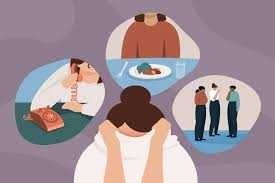
One of the common misconceptions about social anxiety is associating it with shyness. The reason many people don’t seek help for SAD is that they don’t realize that they have a recognized psychiatric condition.
While the two share some characteristics, there are quite a few differences between shyness and social anxiety. The two have such similarities that some think social anxiety is just extreme shyness, while others may be confused about whether they are merely shy or whether they have social anxiety.
What is social anxiety disorder?
Many people get nervous or self-conscious on occasion, like when giving a speech or interviewing for a new job. But social anxiety disorder, or social phobia, is more than just shyness or occasional nerves. Social anxiety disorder involves intense fear of certain social situations—especially situations that are unfamiliar or in which you feel you’ll be watched or evaluated by others. These situations may be so frightening that you get anxious just thinking about them or going to great lengths to avoid them, disrupting your life in the process.
What are the signs and symptoms of social anxiety disorder?
When people with social anxiety must perform in front of or be around other people, they tend to experience certain symptoms, behaviors, and thoughts. A person with social anxiety disorder can have these symptoms during specific types of social situations or they can have them in several or all social interactions.
Physical and physiological symptoms of social anxiety disorder can include:
- Blushing, shaking, sweating, or feeling your heart race during a social event.
- Feeling extremely nervous to the point where you feel nauseated during social situations.
- Avoiding eye contact whilst interacting with others.
- Having stiff body posture around other people.
Thoughts and behaviors to look at that could be signs of social anxiety disorder:
- Avoiding places where you must interact with people a lot.
- Finding it dreadful to be around unknown people.
- Have a feeling that people around you will judge you negatively and reject you.
- Finding yourself go blank and not knowing what to say to other people
What Is Shyness?
Shyness is an emotion that makes people uncomfortable or worried in social settings of any size and affects people of all ages. Shy people may struggle with being authentic when creating connections with strangers.
The struggle to connect with people that shyness causes can also create low self-esteem and low self-confidence. As a result, people might be insecure about their shyness and more self-conscious, creating a cycle of avoiding exposure to people.
Characteristics of Shyness!
Common characteristics of shyness include:
- Being quiet and passive around others
- Displaying nervous behaviors, such as touching your face or twirling your hair
- Feeling like you do not belong or fit in with others
- Feeling insecure or annoyed with yourself for being shy
- Having a desire to be perfect in your social interactions
- Excessively rehearsing how you want to behave/what you want to say to others
- Being hesitant to try something new
Key Differences Between Shyness and Social Anxiety Disorder!
In general, the main symptoms that distinguish shyness from social anxiety disorder are:
- The impairment to cope with one’s life.
- The intensity of fear would be extremely high for a person who is suffering from social anxiety compared to a shy person.
- The level of avoidance would be tremendously high in the case of a person with social anxiety disorder.
People with social anxiety disorder do not just feel nervous before giving a speech. They may worry about the speech for weeks or months beforehand, lose sleep due to anxiety, and have intense symptoms of anxiety during the feared situation such as a racing heart, shortness of breath, sweating, or shaking. All these factors would become a serious impediment to that person’s life.
How do you support yourself and others with social anxiety disorder?
- By educating yourself with information regarding social anxiety disorder. Which includes being aware of the symptoms of SAD, learning about the treatment options, and knowing when to consult a psychiatrist.
- Communicating with people whom you trust. If you notice your loved ones exhibit signs of SAD, set some time aside to have a conversation with them to express your concern and show them your support.
- If you start noticing that SAD is having an impact on your daily life, with your friends or family. Then, it is time to seek professional help from a psychiatrist
Treatment for social anxiety disorder.
Several treatment options can help with social anxiety disorder. How well a therapy works will vary between individuals. Some people only need one type of treatment, but others may need a combination.
The doctor may prescribe a treatment, or they may refer you to a psychologist or other mental health specialist.
Therapy.
Of all the professional treatments available, cognitive-behavioral therapy (CBT) has been shown to work best for treating social anxiety disorder. CBT is based on the assumption about what you think affects how you feel, and your feelings affect your behavior. So, if you change the way you think about social situations that give you anxiety, you’ll feel and function better.
CBT for social phobia may involve:
- Learning how to control the physical symptoms of anxiety through relaxation techniques and breathing exercises.
- Challenging negative, unhelpful thoughts that trigger and fuel social anxiety, replacing them with more balanced views.
- Facing the social situations, you fear in a gradual, systematic way, rather than avoiding them.
Medication.
Medication is sometimes used to relieve the symptoms of social anxiety, but it’s not a cure. Medication is considered most helpful when used in addition to therapy and self-help techniques that address the root cause of your social anxiety disorder.
Three types of medication are used in the treatment of social anxiety:
- Beta blockers are used for relieving performance anxiety. They do not affect the emotional symptoms of anxiety, they can control physical
symptoms such as shaking hands or voice, sweating, and rapid heartbeat.
- Benzodiazepines are fast-acting anti-anxiety medications. However, they are sedating and addictive, so are typically prescribed only when other medications have not worked.
Case Study.
Shreya (name changed) a 25-year-old Software Engineer who is facing social anxiety disorder. She has been struggling with this during most of her life. Since she has started working in a company, with colleagues around her, she has not been able to interact with them, abstains from going to the office and does not attend the call. She has also started avoiding phone conversations with her friends and extended family members, as she believes that they would notice change in her voice and come to know her discomfort. Moreover, she felt that the people around her judged her for her every move and were finding her offensive, which made her feel responsible for it.
One of Shreya’s close friends started to notice her behavior and had a conversation with her regarding this issue. Her friend convinced her to seek professional help and to get treated immediately.
After getting a proper diagnosis from the psychiatrist, she has slowly started recovering from SAD. Although she still feels that she’s responsible for them finding her offensive, she has appeared to have become encapsulated and not to be interfering in her daily functioning in her office. Her interactions with her family, friends and colleagues were normal, and was no longer reluctant to go to her office.
